skip to main |
skip to sidebar
In 2005 I went on a steam driving holiday in Ukraine. That's described in a series of posts:-
Ukraine 2005.
Driving Steam in Ukraine (Part 1).
Driving Steam in Ukraine (Part 2).
Driving Steam in Ukraine (Part 3).
Driving Steam in Ukraine (Part 4).
Driving Steam in Ukraine (Part 5).
Railway Workshops in Kiev.
At the time of my visit to Ukraine in 2005, I'm afraid I was completely ignorant about Russian Railway Signalling practice.
On my visit to the Wolsztyn Experience in Poland in 2003, I'd seen a mixture of semaphore and colourlight signalling (there's a brief post on that trip here) but in Ukraine I only saw colour light signals with electric operation of points.
Signalling at Mikulichin, Ukraine
On Wednesday 26th October 2005, we made our first trip on the single line from Kolomiya to Vorokhta. There's a description of this trip here. We had a wait of around two hours at Mikulichin, awaiting a 'path' onwards to Vorokhta. We spent some time exploring the minor road through Mikulichin before returning to the fairly isolated station, where the friendly lady Stationmaster allowed me to study the signalling and telecommunications facilities.
 The friendly lady stationmaster at Mikulichin allowed me to study the signalling and telecommunications facilities.
The friendly lady stationmaster at Mikulichin allowed me to study the signalling and telecommunications facilities.
 Detail of the signalling control panel at Mikulichin.
Detail of the signalling control panel at Mikulichin.
A couple of Linemen were working in the relay room adjacent to the Stationmaster's Office, so I managed a few pictures of the relay racks.
 The signalling relay room at Mikulichin.
The signalling relay room at Mikulichin.
On Thursday 27th October 2005, the format of the day was similar but this time the run was terminated at Mikulichin. There's a description of this trip here. Whilst waiting for our return 'path' I studied the outside equipment - signals and points.
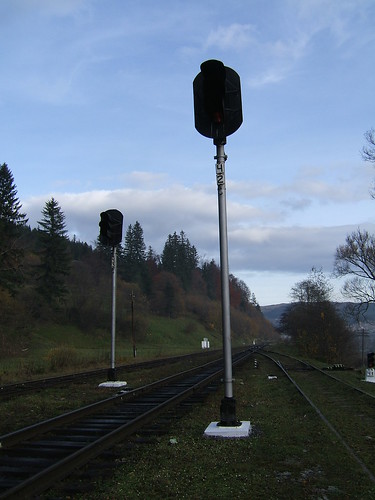
High level 3-aspect colour light 'Exit' signals on running lines.
 Low level 3-aspect colour light 'Exit' signal on siding, with motor-operated trap points in background.
Low level 3-aspect colour light 'Exit' signal on siding, with motor-operated trap points in background.

Another form of low level signal.
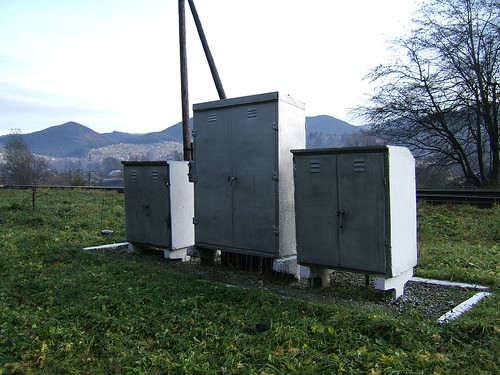 Typical group of trackside equipment cases.
Typical group of trackside equipment cases.
Russian Railway Signalling Practice
Because Ukraine was part of the U.S.S.R. before its dissolution in 1991, signalling in Ukraine reflects Russian practice. The U.S.S.R. and Communist states like China developed largely separately from European railways. OSShD is the Romanisation of the Russian initials 'ОСЖД' - the 'Organisation for the Combined Operations of Railways', referred to as OSSHD in some places. However, this organisation is also referred to as the Organisation for Co-operation between Railways (OSJD).
Wolfgang Meyenberg's site (although not, apparently, being updated) has a simple-to-understand section on signal aspects in the OSSHD/OSJD here.
The Signal Page was started in 2003 in Holland and claims to be the world's largest website on railway signalling systems worldwide. From the index page you can select a variety of articles (not all in English). A good starting point is J. B. Calvert's article here.
Related posts on this website
In 2011, a river cruise from Moscow to St. Petersburg (described in a series of posts here) gave me tantalising glimpses of railways in Russia. Then, in 2011, I travelled by the 'Golden Eagle' private train from Ulaan Baatar to Moscow (described in a series of posts here).
Photographs
Signalling at Mikulichin, Ukraine.
The Old Locomotive Committee (OLCO) is the 'Supporters Club' for the 1838 locomotive 'Lion' and 'Lion' models. The full-size 'Lion' now has pride of place in the Museum of Liverpool adjacent to Liverpool's Pierhead.
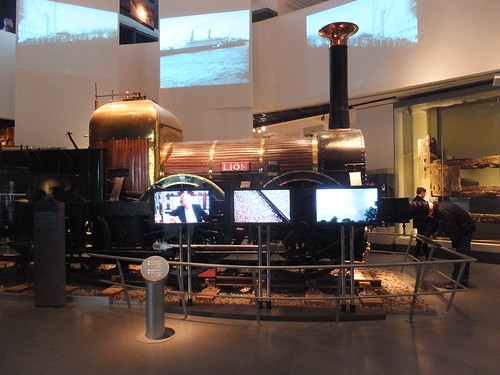 'Lion' in the 'Great Port' Gallery at the Museum of Liverpool.
'Lion' in the 'Great Port' Gallery at the Museum of Liverpool.
The 31st Annual General Meeting of OLCO was held in the Museum of Liverpool on Saturday, 30th May 2015.
The Museum's Curator of Land Transport & Industry, Sharon Brown, was unable to attend this year's meeting but Sharon's colleague Claire Hunter (Assistant Curator of Urban History) made OLCO Members welcome and we are grateful to Sharon and Claire for providing the venue. We were in Education Room 3 on the first floor, which provides spectacular views over the River Mersey.
This was the Fourth time that the A.G.M. had been held at the Museum. There are brief reports on the earlier A.G.M.:-
2012
2013
2014
The Annual General Meeting
The Chairman of OLCO, John Brandrick, opened the formal A.G.M. at 1.00 p.m. and welcomed those attending. This was the first A.G.M. since the death of our Founder and President E.F. Clark and, after a few moments silence, the meeting continued.
The Agenda items were dealt with promptly and the Election of Officers (once again) resulted in no changes to those serving during the previous year. There was lively discussion during 'Any Other Business' and the Chairman closed the meeting at 3.05 p.m. Members of the Old Locomotive Committee have been sent minutes of the proceedings as part of the July 2015 edition of the magazine 'Lionsheart'.
The magazine is currently produced by the indefatigable 'Lionsheart' Editor John Hawley and this publication, alone, is worth the OLCO Membership Fee, which also gives access to the special Members' Area of the OLCO Website.
The River Mersey
I'm afraid I didn't make a photographic record of the proceedings this year. I took a few pictures of the River from our vantage point (which I've added to my album Liverpool). The Mersey Ferry 'Snowdrop' was operating the service but has received a 'paint job'. Last year, 'Snowdrop' was in a dignified livery but she is currently transformed by a 'DAZZLE' livery which is not to my old-fashioned taste. This commission is one of the Word War I Centenary Art Commissions. 'DAZZLE' painting was used extensively in WWI, but the interesting Wikipedia article here seems dubious as to its value.
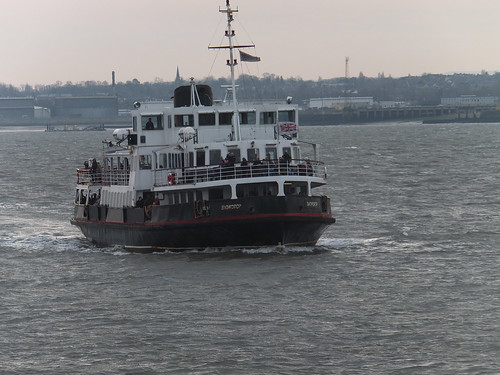 'Snowdrop' looking like a Mersey Ferry in March 2014.
'Snowdrop' looking like a Mersey Ferry in March 2014.
 'Snowdrop' in her current 'DAZZLE' livery in May 2015.
'Snowdrop' in her current 'DAZZLE' livery in May 2015.
More about 'Lion' on my website
The Old Locomotive Committee (an introduction to 'Lion' and OLCO).
All my posts about OLCO activities are here.
More about 'Lion' on OLCO's website
Lion & Old Locomotive Committee (the website of the Old Locomotive Committee).
My OLCO Pictures
All my pictures showing OLCO events are in the collection The Old Locomotive Committee and Lionsmeet.
The Heritage Railcar runs midweek in the season at the Battlefield Line, either as a single-unit 'Bubble Car' or, where additional accommodation is desired, attached to half of a 2-car set (the other half of the 2-car set is currently in the 'Works'). The railcar also operates on various special occasions and, most importantly, can provide a 'Backup' service (sometimes at short notice).
This was the case on Easter Saturday this year when '3803' broke a spring hanger and the diesel railcar 'deputised' whilst repairs were carried out to the steam locomotive. There's a description of the day here.
Sunday 7th June 2015
This was another day that didn't quite work out as planned. Originally I was rostered as steam driver but I was informed that a fireman was not available and asked to operate the service with the diesel railcar instead. I turned up to drive the diesel railcar to find Andy, Carl and Dave preparing '3803' to work the service. Although 3803 was booked to do 5 trips, delay in bringing her into steam meant that I was asked to operate the first trip with the diesel railcar. Andy, Carl and Dave worked the second, third and fourth trips with '3803'.
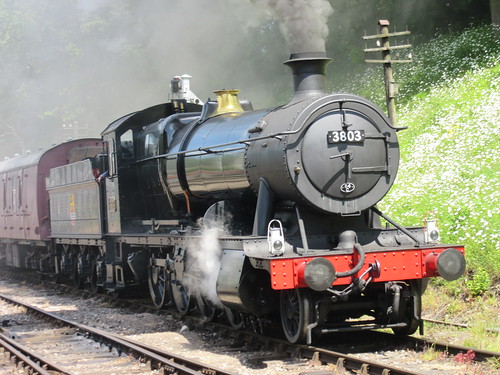 '3803' leaving Shackerstone.
'3803' leaving Shackerstone.
The day was very hot so, on the 4th trip, '3803' was found to be setting the grass alight.
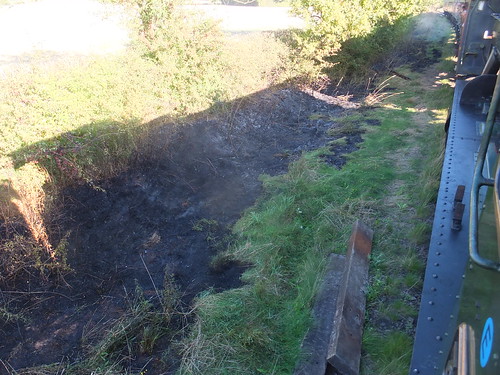 Aftermath of a previous grass fire photographed on 7-Sep-2014.
Aftermath of a previous grass fire photographed on 7-Sep-2014.
To prevent further problems, I was asked to 'fire-up' the diesel railcar again for the last trip of the day, allowing the crew of '3803' to take an 'early bath'.
 The two DMU trips used the single-unit 'Bubble Car'.
The two DMU trips used the single-unit 'Bubble Car'.
Tuesday 7th July
I prepared the 'Bubble Car', swept out the passenger areas and moved down to platform 1 at Shackerstone in plenty of time to work the 11.00 o'clock departure. Unfortunately, because of a misunderstanding, our Guard did not appear. Ritchie Marcus, who owns the railcars and was working on the half of the 2-car set currently in the 'Works', volunteered to act as Guard temporarily. Meanwhile, the Signalman made attempts to contact the rostered guard by telephone. Later in the day, the rostered guard appeared, allowing Ritchie to return to his repair work. The weather was generally good with some intermittent rain and we had a reasonable number of passengers during the day.
Tuesday 21st July 2015
We enjoyed bright sun and an excellent day for passenger numbers. Fortunately, the single unit 'Bubble Car' had been reunited with the in-service half of the 2-car set so we'd sufficient seating available. At Shenton we were joined by a party from a Leicestershire Care Home so the Guard's Compartment became full of wheelchairs and walking frames. The party spent some time at Shackerstone station before posing for a group photograph and travelling back to Shenton and their waiting road transport.
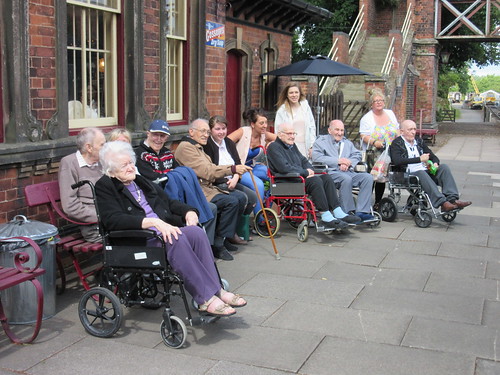 A party from a Leicestershire Care Home pose at Shackerstone for a group photograph before taking the train back to Shenton.
A party from a Leicestershire Care Home pose at Shackerstone for a group photograph before taking the train back to Shenton.
Each of the trains was quite well patronised amd we carried a number of children and parents. At Market Bosworth, railway volunteers were making preparations for the Rails & Ales Event on the 24th, 25th and 26th July. On one trip, the Guard's Compartment carried a Freezer from Shackerstone to Market Bosworth and on the last trip two large, metal wheeled bins were carried!
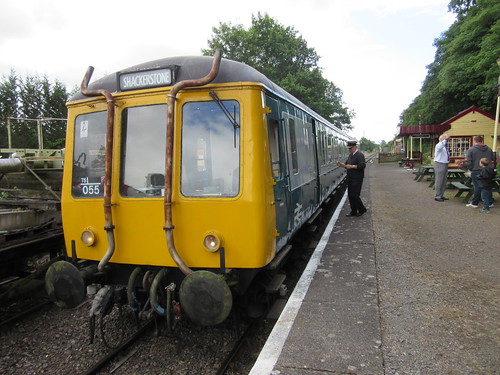 The DMU pauses at Market Bosworth on its way back to Shackerstone.
The DMU pauses at Market Bosworth on its way back to Shackerstone.
Related posts on this site
Diesel Multiple Units.
Midweek Diesel Railcars at the Battlefield Line (2014).
My pictures
Shackerstone, June 2015.
The Battlefield Line, Summer 2015.
I was intrigued to read the following press release:-
PRESS RELEASE - 12 MAY 2015
Dr Pete Waterman OBE DL is delighted to announce that he has reached an agreement with Peak Rail to base his Waterman Railway Heritage Trust assets at its Rowsley site.
Over the coming months, Pete expects to announce exciting plans to overhaul his trust’s steam locomotives, return them to active steaming and in the process provide structured training opportunities for young people interested in a career in the railway industry.
It has always been Pete’s passion to see young people given the chance to learn engineering skills and over the last 30 years or so, he has provided such opportunities to dozens of people via apprenticeships.
Pete said “I have long been an admirer of Peak Rail and they were a natural choice for me when I decided to relocate from the Crewe Heritage Centre. In my time at Crewe, I’m proud to have created hundreds of skilled jobs by providing investment that no-one else had the vision or foresight to do. I intend to work with Peak Rail to continue that tradition”.
 Pete Waterman on the footplate of 8624 on 1st May 2010 when he inaugurated the new turntable at Peak Rail.(Photo: Sheila Rayson).
Pete Waterman on the footplate of 8624 on 1st May 2010 when he inaugurated the new turntable at Peak Rail.(Photo: Sheila Rayson).
On Sunday, 21st June 2015, I was able to have an initial, brief look at two of the Waterman Railway Heritage Trust locomotives now at Peak Rail. This was the day of the Peak Rail Preserved Bus Gathering 2015, which is described here.
Number 5224
This is a Great Western Railway 2-8-0T of the 5205 class, built by Collett in 1923. The design is based on Churchward's 4200 class built between 1910 and 1923.
 5224 outside Rowsley locomotive shed.
5224 outside Rowsley locomotive shed.
Number 5553
This is a Great Western Railway 2-6-2T of the 4575 class, built by Collett between 1927 and 1929. The design is based on the earlier 4500 class. I believe this locomotive claims the distinction of being the last locomotive out of Barry Scrapyard. There's an excellent series of articles on the remarkable story of Barry Scrapyard on the Great Western Archive website, starting with The Barry Scrapyard story, part 1.
 5553 in the sidings at Rowsley.
5553 in the sidings at Rowsley.
My pictures
G.W.R. Locomotive 5224.
G.W.R. Locomotive 5553.
Events of Sunday, 21st June 2015
Once again, I was the driver on 'Lord Phil' with Richard (now a 'Passed Fireman' and able to perform driving turns) as fireman. As usual, we were 'top and tailing' with the Class 31 and a load of six coaches. This was the day of the Preserved Bus Gathering so there were lots of preserved buses on site, making a very colourful scene.
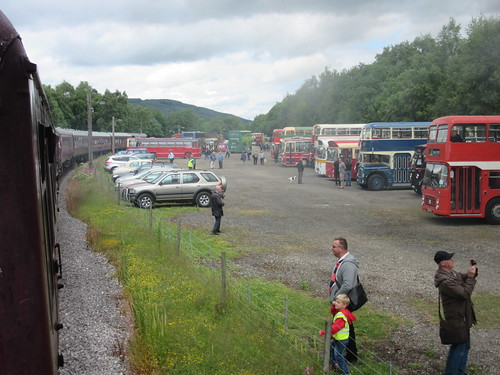 View of Rowsley station car park as 'Lord Phil' sets off for Matlock Town.
View of Rowsley station car park as 'Lord Phil' sets off for Matlock Town.
The Bus Gathering is organised by the Chesterfield 123 Preservation Group and they reported 64 buses attending, of which 24 ran in service. When we passed through Darley Dale during the day, we normally spotted one of the 24 buses in passenger service, making an attractive juxtaposition of train, level crossing and bus.

A London 'Routemaster' parked at Darley Dale station, a long way from Marble Arch.
 Preserved Chesterfield bus passes over the level crossing at Darley Dale.
Preserved Chesterfield bus passes over the level crossing at Darley Dale.
We usually make a special attempt to make our last arrival at Matlock Town on a Sunday 'right time', as passengers from our train are sometimes hoping to make a connection with the East Midlands Trains service to Nottingham. With the various permanent and temporary speed restrictions in force, this is not always an easy task.
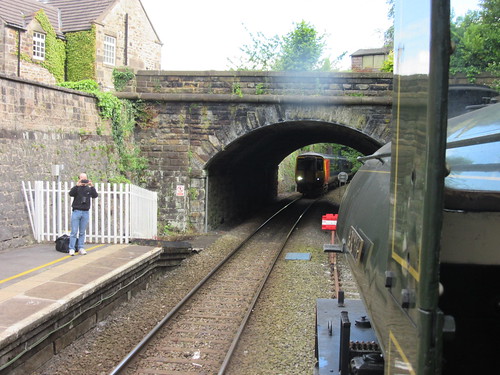 2-car train of Class 156 units arriving at Matlock Town.
2-car train of Class 156 units arriving at Matlock Town.
The Class 31 hauled us back to Rowsley, Richard uncoupled and we took our engine across to the pit outside the engine shed and completed our disposal duties.
 'Lord Phil' stands on the pit outside the engine shed.
'Lord Phil' stands on the pit outside the engine shed.
Related posts on other sites
Chesterfield 123 Preservation Group.
Related posts on this site
Vintage Commercial Vehicles at Peak Rail.
All my posts on Peak Rail can be found here.
My pictures
Peak Rail Preserved Bus Gathering 2015.
A steam engine needs a 'working fluid' to move heat from where it is generated (by the combustion of a suitable fuel) to where it is converted into mechanical energy. Water is boiled to make steam which readily flows to where it is converted into mechanical energy, usually in a reciprocating cylinder. Hence, a railway locomotive must carry water as well as fuel.
In England, steam locomotives were normally identified by counting wheels using Whyte's Notation. For instance '4-6-2' means four leading carrying wheels, six coupled wheels providing traction and two trailing carrying wheels. The English were never seduced by the equally reasonable idea of counting axles until the widespread adoption of diesel and electric traction, although Bullied called his 'Merchant Navy' Pacifics the '2 1 C' class.
If no qualifying letter was appended, it was assumed that there was a tender to carry the required water and fuel so, for instance, '0-6-0' implied a six-coupled locomotive with a tender.
It was convenient to produce designs omitting a tender for shunting or shorter distance working but this meant that the water tank had to be carried on the engine frames, together with the necessary fuel. The suffix 'T' is used to indicate 'Tank' and we call such engines 'Tank Engines'. In Germany, the term 'Tenderlok' is used for designs without a tender.
Early tank engines often carried water in a tank squeezed between the frames, underneath the boiler, rather limiting water capacity but early designers were very wary of raising the centre of gravity. I've driven an 1874 industrial six-coupled locomotive like this called 'Bellerophon' (not to be confused with the L.M.S, 'Jubilee' 4-6-0 of the 1930s). By providing outside cylinders and outside Gooch motion, a reasonable size water tank was included. A 'W' is often added to the designation to indicate 'Well Tank' so 'Bellerophon' is an 0-6-0WT.
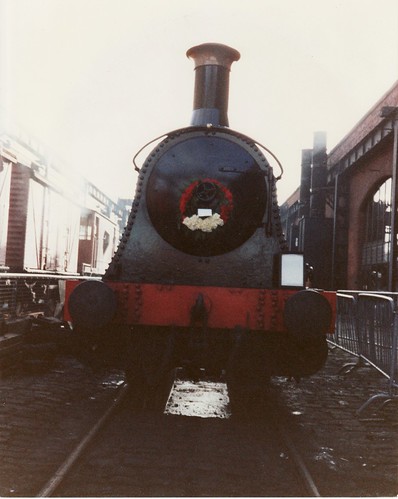
Visiting locomotive 'Bellerophon' at Manchester Museum of Science and Industry, carrying smokebox wreath and explanatory notice on the bufferbeam, commemorating the death of Mick Todd who was closely associated with the restoration of the locomotive.
Beattie designed a 2-4-0WT. I've driven both survivors. He somehow crammed inside motion (Stephenson Link, if I remember correctly) in front of the water tank, severely restricting capacity, so the lower part of the coal bunker is an extra water tank. I've written a post about these delightful engines here.
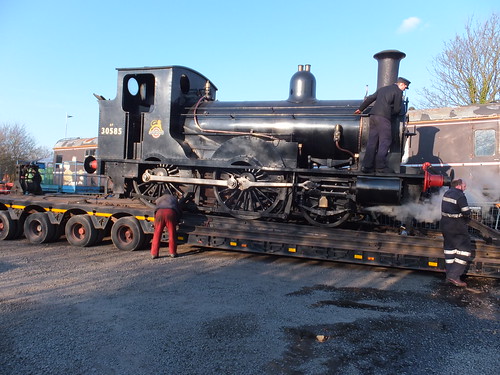 30585, still in steam, is chained in position on the low loader.
30585, still in steam, is chained in position on the low loader.
The 'saddle tank' was widely used, the name suggested by the curved shape of the tank placed on top of the boiler barrel, used particularly in small four-coupled engines like 'Henry' described here. An 'S' is often added to the designation. Saddle tanks are also used on larger 6-coupled locomotives like 0-6-0ST 'Sapper', described here. At least there's some space between the foot-framing (running plate) and the bottom of the tank to perform oiling and inspection. The disadvantage is that the water tank construction is complicated by the need to allow the chimney, dome and safety valves to pierce the tank, unless the tank is shortened to avoid either the chimney or safety valves.
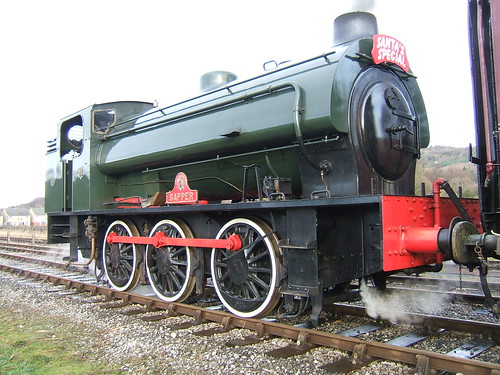 0-6-0ST 'Sapper'.
0-6-0ST 'Sapper'.
Carrying water in two flat tanks either side of the boiler then became a common practice. No extra letter was allocated so, for instance, 'Thomas the Tank' remains simply an 0-6-0T. I've driven a number of side tank locomotives (including a few posing as 'Thomas'). When you prepare a side tank with inside motion (which most British engines had), you quickly find the big disadvantage - access to the motion becomes very difficult, encouraging not-very-ladylike language.
 47298, posing as 'Thomas' shows her classic Midland lines and an odd paint job.
47298, posing as 'Thomas' shows her classic Midland lines and an odd paint job.
My posts on various 'Thomas' locomotives, all side tanks, are here.
The Great Western Railway used side tanks on its larger tank engines - this arrangement probably allows the largest water capacity.
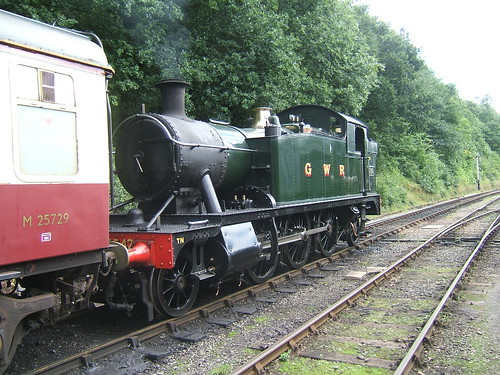 'Light Prairie' 5542 ready to depart from Shackerstone on the Battlefield Line.
'Light Prairie' 5542 ready to depart from Shackerstone on the Battlefield Line.
I'm afraid Britain was very slow to adopt a layout with two outside cylinders and outside Walschaerts motion, which eliminates the problem of access to the motion and allows full-length side tanks, although I've driven at least one such 0-4-0T - 'Cadbury No. 1' built by Avonside which worked at the Bournville chocolate factory.
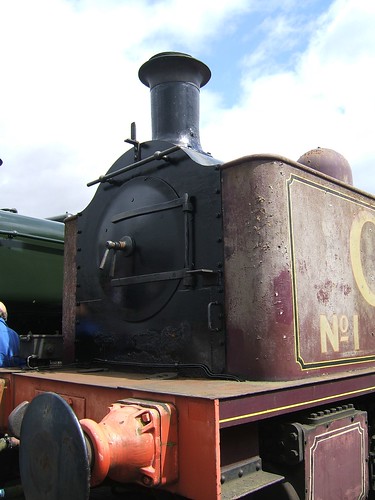
'Cadbury No. 1' has outside cylinders and Walschaerts motion, allowing full-length side tanks. The engine is currently out of traffic.
For their smaller tank engines, the Great Western Railway came up with a tank layout which allowed improved access to inside Stephenson Link Motion. Their solution has much to commend it - they used two 'pannier' water tanks allowing access to inside motion but leaving the top of the boiler unencumbered. A letter 'P' is often added to the designation. I've driven six or seven different 'Pannier' 0-6-0PT but not written a lot about these engines. These are capable, versatile engines and, as my friend John likes to remind me (after I used the phrase on a railway video) "You can do anything with a Pannier". There are some pictures of one example (5786) here. There are pictures of a later version (9466) which, remarkably was not built until 1952, here. I think Belgium was one of the few other countries which used the 'pannier' principle.
 Pannier tank 5786 'on shed' at Shackerstone.
Pannier tank 5786 'on shed' at Shackerstone.
Perversely, when the Great Western Railway did use Walschaerts motion (on the 4-cylinder express engines) they put it between the frames making access even worse than with link motion - just try oiling a 'Castle' or a 'King'. But valve motions are another story.
The Post Title
"Water, water, every where" is a line from The Rime of the Ancient Mariner by Samuel Taylor Coleridge.
On Sunday, 12th April 2015, Pathfinder Tours (2006) Ltd organised a Midlands rail tour, hauled by a pair of Class 20 from Direct Rail Services. Their advertising material said:-
No not a Trumpton tour but to locations in the Derwent Valley - an intriguing ramble around unusual lines in the Midlands, headed by English built locomotive types that are still giving sterling service over fifty years since built. With plenty of non-passenger line coverage we hope this Midlands perambulation will appeal to you. The on board catering will include both a buffet service, real ales and the Gricers Grill (with 'Roastie' option). MOTIVE POWER IS EXPECTED TO BE DRS CLASS 20 DIESEL LOCOMOTIVES WITH A DRS CLASS 37 ASSISTING IN THE MORNING BETWEEN DUDLEY RUN ROUND SIDING AND BROMSGROVE. Pick up stations: Crewe, Stafford & Walsall.
N.B. Trumpton’s fire brigade roll was :Pugh, Pugh, Barney McGrew, Cuthbert, Dibble and Grub.
Well, the Trumpton allusions were lost on me, but help was at hand in the Trumpton article on Wikipedia.
This railtour was ending up at Rowsley on Peak Rail and I was rostered as steam driver on the Peak Rail service. As usual, we were top-and-tailing with 'Lord Phil' on the south end of the train. The timetable was amended so that the Peak Rail train was waiting in the Up Platform at Darley Dale, allowing the 'special' to pass us using the Down platform on its way to Rowsley.
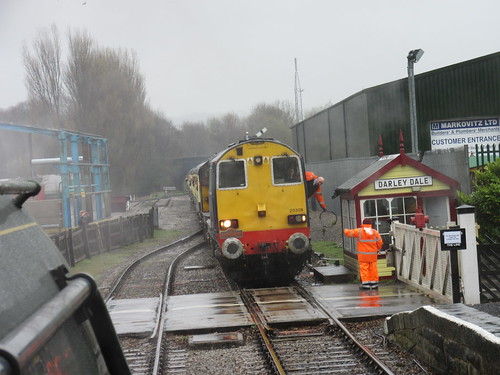 Peak Rail, 2015: The Pathfinder Railtour passing Darley Dale en route to Rowsley. Jack, the Peak Rail Conductor, surrenders the Matlock-Darley Dale token to the Darley Dale Signalman.
Peak Rail, 2015: The Pathfinder Railtour passing Darley Dale en route to Rowsley. Jack, the Peak Rail Conductor, surrenders the Matlock-Darley Dale token to the Darley Dale Signalman.
We then proceeded to Matlock Town, returned to Darley Dale and stood in the Down platform. Meanwhile, the pair of Class 20 had run round the train at Rowsley and returned to Darley Dale, stopping in the Up platform. The railtour had to wait for the 'road', giving us a chance to chat to the Direct Rail Services driver before we continued to Rowsley.

Peak Rail, 2015: The returning Pathfinder Railtour arriving at Darley Dale.
Direct Rail Services:
I hadn't realised until I wrote the post Furness and the Cumbrian Coast (Part 1) that Direct Rail Services was owned by the Nuclear Decommissioning Authority which is an Executive Non-Departmental Public Body (NDPB) reporting to the Department of Energy and Climate Change. Originally, it solely operated nuclear flask trains, but its work has now expanded and you can find out more here.
Other Railtours at Peak Rail
There have been a number of Railtours to Rowsley, some of which I've described in this blog:-
Steam Charter to Peak Rail.
The 'Peak Forester'.
HST Charter to Peak Rail.
My pictures of the Dimple, Darley and Dale
Peak Rail 2015 (part of album).
Brewood Garden Party took place at Brewood Hall on the 11th July 2015. This event was held at Brewood Hall for the first time in 2013 (there's a report here) and was repeated the following year (report here). The first two years had been blessed with hot, sunny weather and I'm pleased to report that the 2015 event enjoyed similar conditions.
Setting up
On the evening of the day before the Garden Party, a large number of Scouts and Scout leaders arrived to unload the various vehicles and trailers bringing the materiel needed, erect the various tents and sort the equipment ready for the final preparations on Saturday morning.
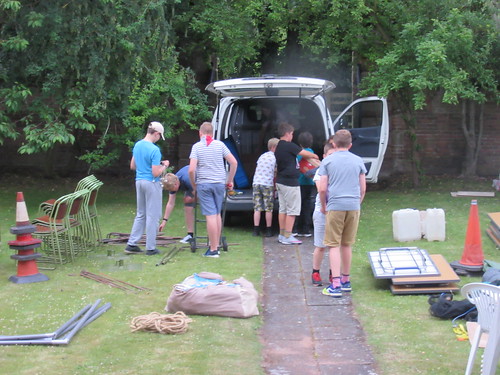 Unloading the first of many deliveries of equipment needed for the garden party.
Unloading the first of many deliveries of equipment needed for the garden party.
The volunteers worked quite late. As previously, two large modern frame tents were erected as the refreshment area and a similar tent was set up for games and stalls. The most demanding task was erecting the large canvas marquee which required good teamwork.
 Erecting the large marquee.
Erecting the large marquee.
There was also a 'gazebo' tent and a futuristic-looking Coleman Event Shelter (I didn't know the Coleman brand but there's quite a nice video illustrating the history of the Company here. After watching the video, the 'Back Button' will return you to this post).
On Saturday morning, volunteers arrived to complete the setting-up, ready for the opening to the public at 1.00 p.m.
The Garden Party
By the time all was ready to admit visitors, a small queue had formed outside the entrance gates.
 The entrance gates, viewed from the road.
The entrance gates, viewed from the road.
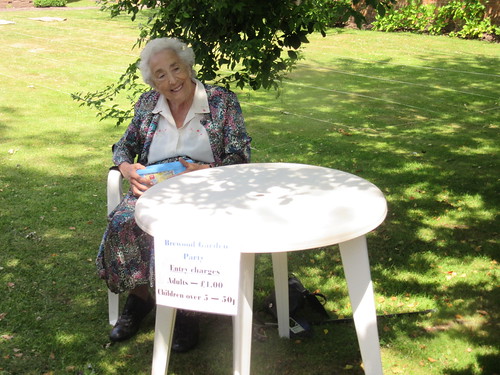 My friend Rita manned the Admission Table.
My friend Rita manned the Admission Table.
Marilyn Coulter from the parish church performed the official opening (before dashing back to St. Mary's and St. Chad's to perform a wedding, after which she returned to the garden party). A popular innovation this year was live music performed by two bands from the Cannock Performing Arts Centre:-
The 'Wind Band' at 1.15 p.m.
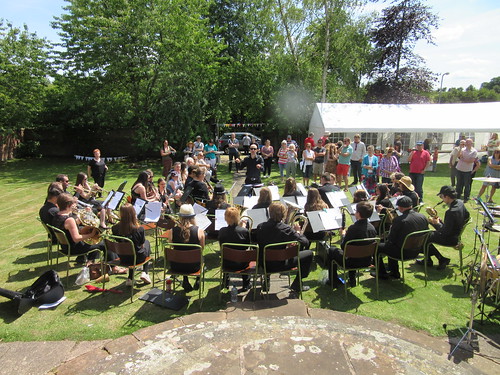 Cannock Performing Arts Centre 'Wind Band'.
Cannock Performing Arts Centre 'Wind Band'.
The 'Big Band' at 2.30 p.m.
 Cannock Performing Arts Centre 'Big Band'.
Cannock Performing Arts Centre 'Big Band'.
There's also a short video of the 'Big Band' here. After watching the video, the 'Back Button' will return you to this post.
Both bands are supported by the Friends of Cannock Performing Arts Centre who manned a stand.
 Friends of Cannock Performing Arts Centre - 'Supporting young musicians'.
Friends of Cannock Performing Arts Centre - 'Supporting young musicians'.
The P.D.S.A. and the Staffordshire Corps of Drums manned stands. 'The Trading Post' (which is Brewood Scouts own charity shop in Brewood) moved some of their stock to a stall at the garden party and the volunteers were kept busy. The large marquee hosted a number of craft stalls, a sweet shop and the judging for the cake-making contest. The refreshment tent was, as always, popular. The good weather encouraged many visitors to sit at the tables which had been provided outside the tent.
 The refreshment tent.
The refreshment tent.
Various games were laid on. The wet sponge throwing at a human target was always busy, as was the Coconut Shy.
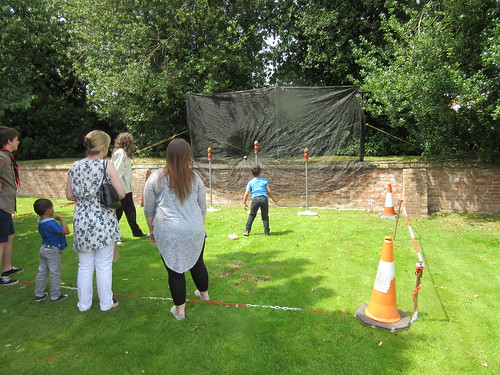 The Coconut Shy.
The Coconut Shy.
Another traditional entertainment for younger visitors was provided by a series of Sack Races and Egg and Spoon Races. These proved very popular.
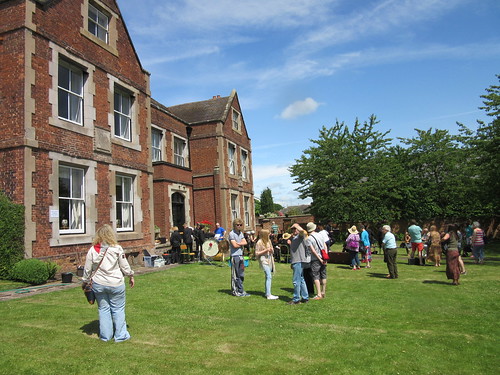 Visitors were able to enjoy the location and the sun.
Visitors were able to enjoy the location and the sun.
Everybody seemed to enjoy their visit and useful funds were generated which, this year, were divided between Brewood Scouts and the Jan Ford Foundation (supporting educational and medical charitable work in Myanmar).
Related posts on this site
Brewood Vintage Garden Party 2013.
Brewood Vintage Garden Party 2014.
More information on the charitable work supported by the Jan Ford Foundation in Myanmar (formerly Burma) can be found:-
Education Support
Medical Support.
Pictures of the event
Brewood Garden Party 2015
On Easter Saturday 4th April 2015, I was booked out on '3803' with Dave as fireman. We both set-to to prepare the locomotive, Dave concentrating on steam-raising whilst I 'oiled round' and carried out the 'Daily Exam'. It can get rather smokey inside the shed so, as soon as we had sufficient steam to move the locomotive safely, I moved the engine outside.
 3803 outside the shed at Shackerstone.
3803 outside the shed at Shackerstone.
3803 looked very business-like in her new unlined black livery (thanks to Jason's hard work) with the original British Railways insignia on the tender, which we used to call the 'Lion astride a Mangle-wheel'.
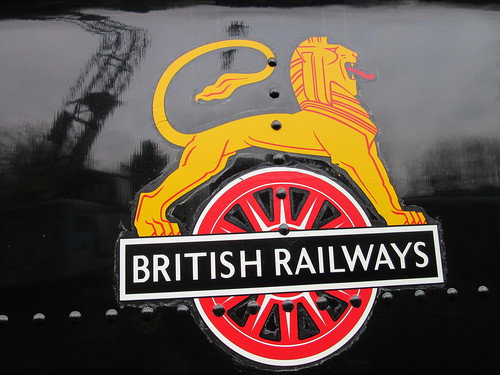
There were spare vehicles attached to the passenger stock in platform 2 and an '04' shunter. I'd worked out how we could shunt them out of the way with '3803' but Adrian arrived and carried out the shunt, allowing us to move across to our train in platform 2 in plenty of time for the first departure at 11:15. The locomotive carried a special headboard 'EASTER EGGS-PRESS'.
Leaving Market Bosworth on the first service, there was a bit of a 'thump'. Since the locomotive had suffered a run of broken springs, any loud noise from 'underneath' triggered an inspection of springs at the earliest opportunity but at Shenton Dave's examination found no problem and I thought the noise was probably from the intermediate buffers between engine and tender which were known to produce the occasional 'bang'. However, on the second trip as we left Market Bosworth, I caught a glimpse of an odd-looking 'lump of metal' in the cess and spent the rest of the journey to Shenton trying to decide what it might have been. I'd more or less worked it out by the time we stopped at Shenton, so I climbed down and found one spring hanger on the middle tender axle missing. After a telephone discussion with Adrian, we ran round and gently worked the train back to Market Bosworth, where Adrian met us and we made an unsuccessful search for the missing spring hanger. It was agreed that we would cautiously work the train back to Shackerstone where Adrian would attempt a temporary repair.
To prevent a long interruption to the service whilst the repair was carried out, it was decided that I'd 'fire-up' the Diesel Multiple Unit (DMU), running as a single-unit railcar attached to a motor car from the 2-car set). Leaving Market Bosworth on the way out, we kept a sharp look-out and, this time, located the broken spring hanger which Dave lifted on board. Dave drove the DMU back to Shackerstone since he was training to pass-out as a DMU Driver.
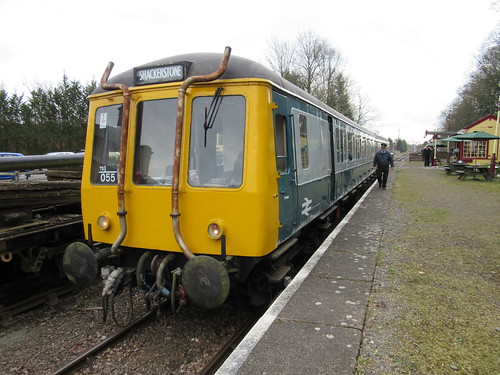 The DMU pauses at Market Bosworth on the way back to Shackerstone.
The DMU pauses at Market Bosworth on the way back to Shackerstone.
We disposed of the DMU on the railcar siding and returned to '3803', where Adrian had carried out a splendid repair. I've never heard of a spring hanger fracturing on a Great Western pattern tender before.
 The temporary repair to the spring hanger on the middle tender axle, driver's side.
The temporary repair to the spring hanger on the middle tender axle, driver's side.
The final trip of the day was carried out with '3803'. Dave drove out to Shenton (he's also training to pass-out as a steam driver) and I drove back. A tiring, but very interesting, day.
 '3803' ready for action on the last round-trip.
'3803' ready for action on the last round-trip.
My pictures
Easter 2015 at the Battlefield Line
I was rostered to drive at Peak Rail on Saturday, 21st March 2015. My previous turn on 1st March had encountered rain, sleet and snow (see report here): in contrast, the 21st March started dry but cold and during the day we enjoyed bright sun. Fate had other challenges, rather than the weather, to test Dave, the Fireman, and I. We had two one-hour Driving Experience courses before the service so it was an early start for me, even earlier for Dave.
'Lord Phil' certainly looked the part, standing on the outside pit in clean condition with plenty of polished brass on display and 'brewing up' nicely. However my priority was to oil round and carry out the daily exam. That meant the usual exercise of applying 'motion oil' to the six crankpins, the various oil boxes and oil pots, leaning in between the frames to reach the oil cups and oil holes on the motion. This usually involves climbing up onto the foot framing, dealing with the accessible oiling points, then climbing down to the ground and up again in various positions until most oil points are dealt with, leaving perhaps a few locations to be reached whilst in the pit underneath the locomotive whilst at the same time inspecting springs, motion and, well, everything.
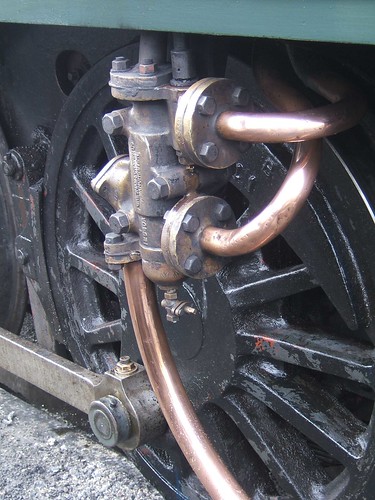
Fireman's side Injector on an 'Austerity' ('Royal Pioneer').

Fireman's side Combined Steam and Delivery Valve and 'Klinger' Gauge Frame on an 'Austerity' ('Royal Pioneer').
There's a PDF of the Davies and Metcalfe publication 'Monitor Type Locomotive Live Steam Injector' here which will repay careful study. Relevant to 'Lord Phil' are the Combined Steam and Delivery Valve (on page 20) and the Non-Lifting Live Steam Injector 'Austerity' type (shown on page 22).
Dave knew there had been problems previously with the fireman's side injector failing to shut off properly after use resulting in steam and/or water discharging from the overflow pipe. The injector on the driver's side wasn't much better but we agreed to see how things went during the first Driving Experience course. When people are looking forward to a driving experience, may have travelled a considerable distance and, often, incurred accommodation costs, I hate to disappoint them, but, of course, safety is always the top priority. I do remember having to declare a failure on 'Royal Pioneer' when the regulator linkage in the steam dome became detached - that's described here.
We were having serious trouble with loss of water but we managed to complete the two driving experience courses and then attempted to water before the first service train, using the brown water tank at the south end of the platform only to discover that the brown tank wagon was out of water. I discussed with Gordon the easiest solution and we agreed to swop the engines round, with 'Penyghent' on the south end and 'Lord Phil' on the north end. This meant that we could reach the Grey water tank at the north end of the platform which is currently little-used. The grey water tank is much easier to use (provided you stop in the right place), because, instead of dragging a long fire hose around, there is just a hinged delivery pipe which swings across to the tank filler. This also gave a bit of variety in that we hauled the train uphill, rather than downhill, and did so bunker-first.
 'Lord Phil' at Matlock, ready to haul the service train back to Rowsley.
'Lord Phil' at Matlock, ready to haul the service train back to Rowsley.
Neither Dave nor I thought the arrangements ideal but we managed to run the service all day. One or two people enquired about the locomotives being the opposite way round to normal.
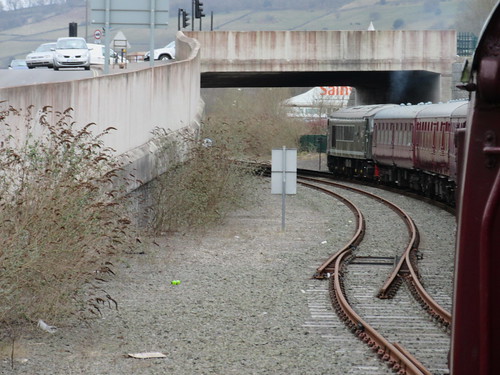 Peak Rail: 'Penyghent', unusually on the south end of the train, approaches Matlock, viewed from 'Lord Phil' on the north end.
Peak Rail: 'Penyghent', unusually on the south end of the train, approaches Matlock, viewed from 'Lord Phil' on the north end.
I think this was Penyghent's 'swan song' before being taken 'Out of Traffic' for a major overhaul.
My pictures
Peak Rail 2015.
 The friendly lady stationmaster at Mikulichin allowed me to study the signalling and telecommunications facilities.
The friendly lady stationmaster at Mikulichin allowed me to study the signalling and telecommunications facilities.
 Detail of the signalling control panel at Mikulichin.
Detail of the signalling control panel at Mikulichin.
 The signalling relay room at Mikulichin.
The signalling relay room at Mikulichin.

 Low level 3-aspect colour light 'Exit' signal on siding, with motor-operated trap points in background.
Low level 3-aspect colour light 'Exit' signal on siding, with motor-operated trap points in background.

 Typical group of trackside equipment cases.
Typical group of trackside equipment cases.












































